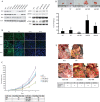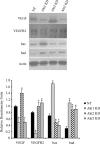Akt isoform specific effects in ovarian cancer progression
- PMID: 27533079
- PMCID: PMC5342704
- DOI: 10.18632/oncotarget.11204
Akt isoform specific effects in ovarian cancer progression
Abstract
Ovarian cancer remains a significant therapeutic problem and novel, effective therapies are needed. Akt is a serine-threonine kinase that is overexpressed in numerous cancers, including ovarian. Mammalian cells express three Akt isoforms which are encoded by distinct genes. Although there are several Akt inhibitors in clinical trials, most indiscriminately target all isoforms. Current in vitro data and animal knockout experiments suggest that the Akt isoforms may have divergent roles. In this paper, we determined the isoform-specific functions of Akt in ovarian cancer cell proliferation in vitro and in ovarian cancer progression in vivo. For in vitro experiments, murine and human ovarian cancer cells were treated with Akt inhibitors and cell viability was assessed. We used two different in vivo approaches to identify the roles of Akt isoforms in ovarian cancer progression and their influence on the primary tumor and tumor microenvironment. In one experiment, wild-type C57Bl6 mice were orthotopically injected with ID8 cells with stable knockdown of Akt isoforms. In a separate experiment, mice null for Akt 1-3 were orthotopically injected with WT ID8 cells (Figure 1). Our data show that inhibition of Akt1 significantly reduced ovarian cancer cell proliferation and inhibited tumor progression in vivo. Conversely, disruption of Akt2 increased tumor growth. Inhibition of Akt3 had an intermediate phenotype, but also increased growth of ovarian cancer cells. These data suggest that there is minimal redundancy between the Akt isoforms in ovarian cancer progression. These findings have important implications in the design of Akt inhibitors for the effective treatment of ovarian cancer.
Keywords: Akt inhibitors; Akt isoforms; ovarian cancer; tumor development.
Conflict of interest statement
The authors declare no conflicts of interest.
Figures








References
-
- Siegel RL, Miller KD, Jemal A. Cancer statistics, 2016. CA Cancer J Clin. 2016;66:7–30. - PubMed
-
- Aletti GD, Gallenberg MM, Cliby WA, Jatoi A, Hartmann LC. Current management strategies for ovarian cancer. Mayo Clin Proc. 2007;82:751–770. - PubMed
-
- Noske A, Kaszubiak A, Weichert W, Sers C, Niesporek S, Koch I, Schaefer B, Sehouli J, Dietel M, Lage H, Denkert C. Specific inhibition of AKT2 by RNA interference results in reduction of ovarian cancer cell proliferation: increased expression of AKT in advanced ovarian cancer. Cancer Lett. 2007;246:190–200. - PubMed
MeSH terms
Substances
LinkOut - more resources
Full Text Sources
Other Literature Sources
Medical
Miscellaneous

